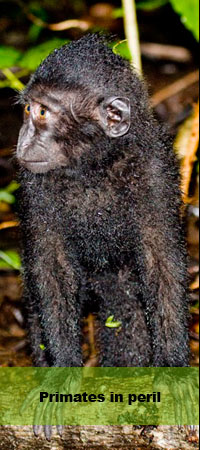|
More than half the world’s primates, including apes, lemurs and monkeys, are facing extinction. The main threats are well-known which include habitat loss especially the clearing of tropical forests, and the hunting of primates for food and the illegal wildlife trade.
The world’s 25 most endangered primates include five species from Africa, five from Madagascar, ten from Asia, and five from the Neotropics. Madagascar tops the list with five species. Indonesia and Vietnam both have three, Brazil two, and Cameroon, China, Colombia, Côte d’Ivoire, the Democratic Republic of Congo, Ecuador, Ghana, India, Kenya, Nigeria, Peru, the Philippines, Sri Lanka, Tanzania and Venezuela each have one
The lemurs, endemic to Madagascar, are one of the world’s most endangered mammals. They are mostly the victims of poor law enforcement and habitat destruction. For example, the Lac Alaotra Bamboo Lemur (Hapalemur alaotrensis) is endemic to a unique marshland habitat (this is the only primate to live in marsh habitat) located in Madagascar’s largest lake. Any destruction or additional impacts on the dense papyrus and reed beds (habitat) surrounding the lake would precipitate this lemur toward extinction.
In Africa, too many species are also facing terrible decline. For example, the Roloway monkey (Cercopithecus diana roloway) from Gahana and Côte d’Ivoire is on the verge of extinction. This is an upper-canopy specialist that depends on undisturbed forest habitat. Destruction and degradation of its habitat and aggressive hunting for the bushmeat trade have reduced its population to small isolated pockets. The protection of its remaining pristine forest habitat (especially the Tanoé and Kwabre Forests) should be the highest conservation priority.
In Southeast Asia, illegal wildlife trade and habitat destruction are bringing many primates close to extinction. In the Philippines, the endemic Philippine tarsier (Carlito syrichta) is among the world’s 25 most endangered primates. This small secretive species is highly threatened due to human overpopulation, lack of law enforcement, and continued illegal deforestation, in particular within secondary forest.
Endangered Species International (ESI) is strongly engaged in saving endangered primates including their habitats such as rainforests and marshes. ESI has been working directly in the field where habitat destruction and illegal wildlife poaching occur. We don’t debate solutions and plans in offices, our “offices” are the habitats of primates where we execute activities that directly protect them. Our long-term field activities are the best voice for primates. ESI has stopped illegal gorilla hunting in some parts of Congo saving life of many gorillas, providing a safe haven in their home forest. We actively protect and restore 509 hectares of habitat for the endangered Philippine tarsier. ESI has been engaging, empowering and supporting indigenous communities to protect primates and other wildlife.
To protect primates and their habitats, we work on many fronts such as law enforcement, education, and creating effective protected areas. ESI is a proof that we can save primate species and their habitats. Join us to continue achieving remarkable conservation results! Your support is needed now more than ever. To every one of our generous and committed supporters, we thank you. If you need further information on a particular project contact us here!
Links
 
|









